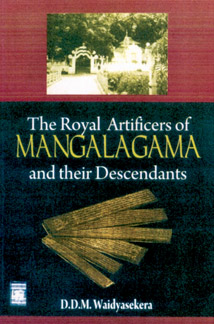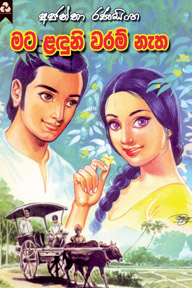|
Book Review
History, ancestry and descendants
Title : The Royal Artificers of Managalagama
and their Descendants
Author : D D M Waidyasekera
Genre : Factual History
Publisher : Stamford Lake (Pvt) Ltd.
In its long history of over 2500 years, Sri Lanka has produced a host
of historic sites, families, architecture, arts and crafts, folklore
among other traditions in different parts of the country.
 It is difficult to trace the ancestry and history of these families
and their works for lack of consistent records but a number of sources
including official documents, records from the National Archives and
other Libraries, various sannasas granted by the Sinhala Kings,
lekammiti, vittipatra, tudapat, kadaimpoth etc. and research of other
scholars among other sources are avilable to the earnest researcher. In
the case of artificers or craftsmen, the task is more difficult for as
Ananda Coomaraswamy states. “The names of artificers are not recorded in
their work nor as a rule remembered except by their own descendants.” It is difficult to trace the ancestry and history of these families
and their works for lack of consistent records but a number of sources
including official documents, records from the National Archives and
other Libraries, various sannasas granted by the Sinhala Kings,
lekammiti, vittipatra, tudapat, kadaimpoth etc. and research of other
scholars among other sources are avilable to the earnest researcher. In
the case of artificers or craftsmen, the task is more difficult for as
Ananda Coomaraswamy states. “The names of artificers are not recorded in
their work nor as a rule remembered except by their own descendants.”
TRACING THE ANCIENT
This book is an attempt to trace the history and ancestry and the
works as well as the descendants, of the royal artificers of an ancient
village Mangalagama in the Kandyan Udarata. The village itself lies on
the 54th milepost on the Colombo-Kandy road and is markedly visible by
two of its characteristics in the form of its ancient Vihare and the
ancient amabalama, now renovated. The village assumes historical
importance because as Paranavitana states, “The role played by the
Mangalagama craftsmen in the Kandyan Court was unique.”
The study commences with a description of the origins of the clan of
artificers in India, its mythical ancestor Viswakarma regarded as the
revealer of the science of architecture and mechanics, their advent to
Sri Lanka both before and after Vijaya in 483 BC and Sanghamitta who
brought the Bo-tree in 289 BC. The origins of the village, its Bo-tree
and ambalama are traced more particularly from the 15th century AD.
During the reign of Bhuvaneka Bahu VI of Kotte (AD 1469-1477) there
came a reputed Mulachariya from Dambadiva, who was brought to Kotte with
full honours on the King's own elephant. The Mulachariya presented the
king with a telescope and an hour glass (clock), in return for which the
King granted him the village of Mangalagama as a nindagama and bestowed
on him the title Mandalawalli. All these facts and the Sannasas granted
are recorded in the Vitti Patraya and given in Bell's Report on the
Kegalla District 1892 and produced in the Appendix to the book.
UNIQUE INSCRIPTIONS
Another chapter of the book gives particulars regarding the various
sannasas granted at different times by the Sinhala Kings to the
descendant families particularly in the Kandyan districts and supported
by reference to such researchers as Codrington, Lawrie's Gazetteer, Bell
etc.
The details of the Mangalagama Vihare, and Bo-tree, particulars of
the ancient ambalama especially its unique timbered roof and decorated
pekada pillars as described so aptly in Ananda Coomaraswamy's
masterpiece “Medieval Sinhalese Art” are provided in detail with
relevant illustrations and gives a fascinating insight in to the
uniqueness of some of the historical structures of the country.
Another feature of the study is the author's research into the life
and works of the unique Kandyan designer and architect builder Dewendra
Mulachariya who is credited with designing and construction of the
Pattiripuwa or Octagon of the Dalada Maligawa, other such works as the
Magul Maduwa or Audience Hall and the highly original concept of the
Cloud Wall or Walakul Bamma surrounding the Kandy Lake.
He worked under three Kings, Kirti Sri Rajasinha, Rajadhi Rajasinha
and Sri Wickrema Rajasinha.
However, little is known or has been written of the life and works of
this brilliant Kandyan designer builder.
His other architectural works and the stories behind the building of
the Octagon, Magul Maduwa, the Cloud Wall are described which provide an
interesting insight into the intrigues prevalent in the Kandyan Court at
the time and which ultimately led to his drowning himself in the Kandy
Lake. The author has also researched into his family and descendants
based on the Judicial Commissioner's Court Proceedings of the early
nineteenth century in the Kandy Archives.
Another interesting feature of the book is the description of the
works of the Kandyan painters of Sittaru, during this period.
As a rule the names of the painters themselves are not given in the
paintings and are known mosltly through the various sannasas granted by
the Kings as a reward for their work. Illustrations are provided of some
of the wall paintings in Dambulla, Gangarama, Degaldoruwa, Ridi Vihare
and the Dalada Maligawa and the names of the relevant painters are given
in the book.
EVOLUTION
Illustrations and descriptions are also provided of the jewellery and
other ornaments produced for the Kings by the Mangalagama royal
artificers as well as specimens of the ancient Sinhala royal crowns and
the evolution of their designs from the Anuradhapura period (including
that of Dutugemunu and Valagamba) to the 18th and 19th centuries and
which is a unique feature of the book.
The contents of the book would be of interest to scholars,
researchers, students, historians, social scientists as well as to the
general reader alike.
Pemsiri de Silva
Challenges encountered by rural folk
Title : Mata Landuni Waram Netha
Author : Dr Ajantha Ranasinghe
Genre : Novel
Publisher : Dayawansa Jayakody
Mata Landuni Waram Netha was the first novel written by the veteran
journalist and lyric writer Dr Ajantha Ranasinghe. The storyline in a
nutshell elaborates on the happenings contributed towards suppression of
the rich values of rural culture in our country with the invasion of the
urbanized social order and thus the conversion.
 Story revolves around two young lovers. Kumara Mahaththaya with a
rural background is sent by his parents to the city, to obtain English
education. He meets Anula, an urban damsel who attracts Kumara with her
charms. Eventually Anula who leads a fast life style dumps Kumara for
her new lover in Colombo. Story revolves around two young lovers. Kumara Mahaththaya with a
rural background is sent by his parents to the city, to obtain English
education. He meets Anula, an urban damsel who attracts Kumara with her
charms. Eventually Anula who leads a fast life style dumps Kumara for
her new lover in Colombo.
A string of events nicely woven in the story shows how the rural folk
who respected the age old customs of their society are eventually driven
to the extent of challenging leaders in their society; doctor (Veda
Mahaththaya) and the Buddhist Priest.
The surge of resistance by the emerging youth population towards the
doctor’s family is eventually accepted with the right spirit by the wise
Doctor. He steps down gracefully, appreciating and giving way to the
enthusiasm and vigour of the youth.
The doctor’s family is respected by all village folk. Kumara the
eldest son has a socialistic temperament. His younger brother is a
business minded person who demands respect from the poor rural folk.
In contrast, Kumara has the humbleness and liking to mingle with the
poor people in village. He is bold enough to go to the extent of sharing
a cigarette with a guy whom he meets at Gamae Kopi Kadae. Doctor’s wife
(Kumara’s mother) is a strong woman who is bound to safeguard her family
from all odds. Her harshness at times is purely due to her commitment
towards the family and its betterment.
The story also talks about romance, deception and despair. Kumara, a
very emotional and romantic lad is loved by everyone in the village.
Even the damsels who come from the rear entrance of the doctor’s house
to serve the doctor family are attracted to him.
Through the lives of Kumara and Anula, the author takes the reader on
a tour in city and village screening the contrast difference in values
and attitudes of inhabitants in the city and village folk.
Writing a review of the book, Prof. Sunanda Mahendra says:
‘Challenges encountered by the rural folk with the impact of modern life
style is highlighted in the story.’
The poetic rhythm maintained throughout the novel by the author was
commended by Edwin Ariyadasa. He had said, Ajantha had brought to the
surface the attributes in a virgin village which really existed in good
old days.
The short novel has the magic of keeping the reader engrossed to it
until the end. The author could have easily elaborated the story further
to discuss to a greater extent; the socio-economic changes took place in
the country within few decades. Had he done that while having emphasis
on the love story, the novel could have been a masterpiece.
Mata Landuni Waram Netha was first published in 1975 and the second
publication came in 2011.
- Channa Bandara Wijekoon
[email protected]
|



